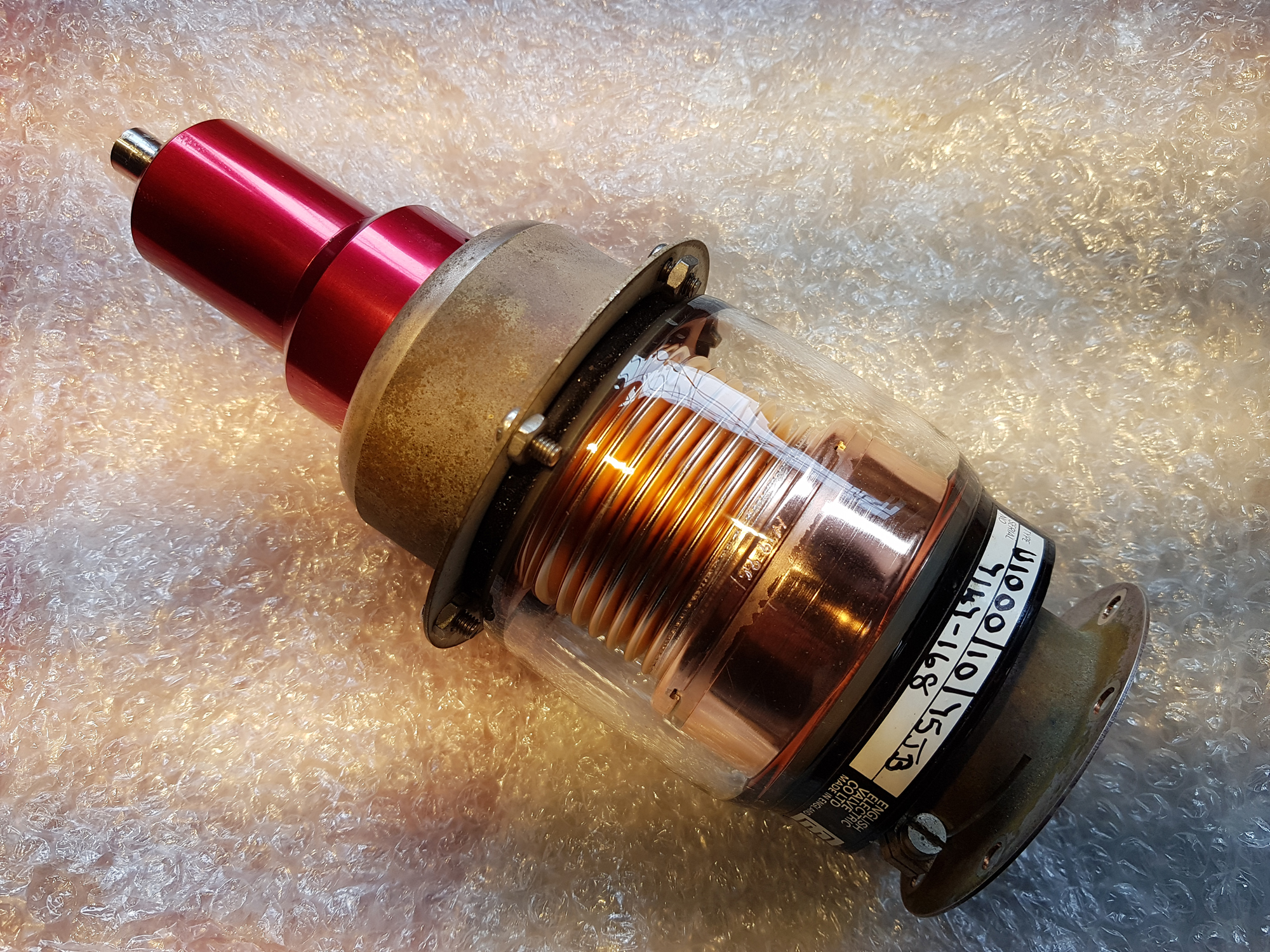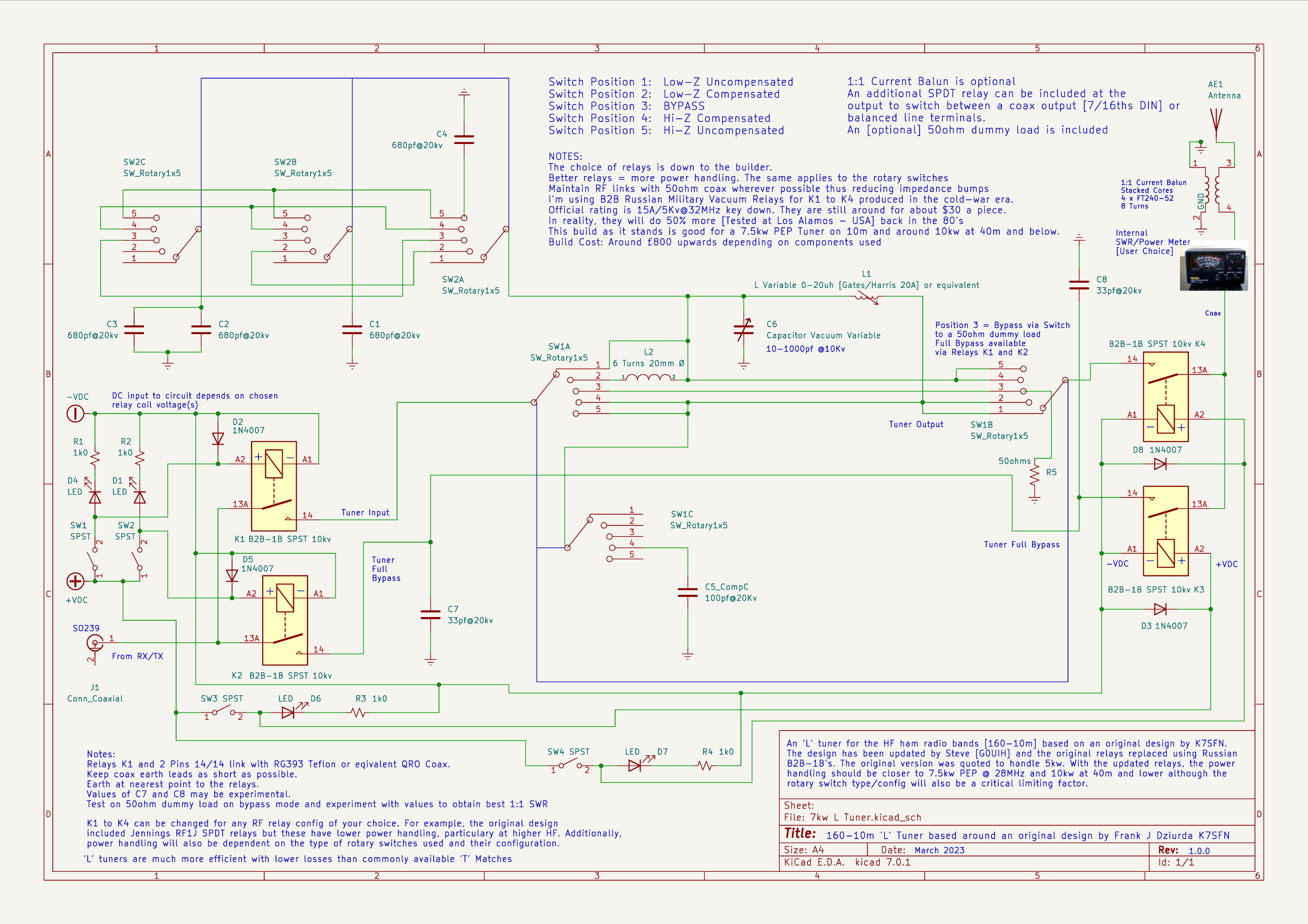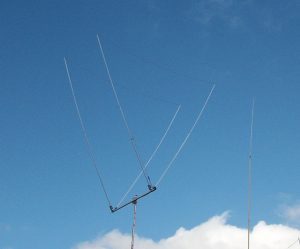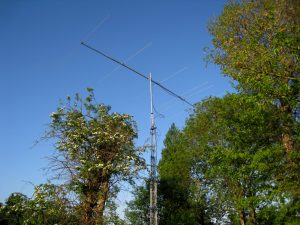The Ultimate ‘L-Match’ ATU based on an original design by Frank J. Dziurda Jr, K7SFN
**Project Progressing Summer/Autumn 2025**
As mentioned below, the project was put on hold in 2024 because of major issues with the turns counters. Having been busy this year, I’ve now had the chance to look them over. Both have been disassembled and cleaned. Re-assembly was a nightmare and took a huge amount of time but has worked to a point. They drive much better than before although not 100% ‘true’ so to compensate for the out of ‘true’ drive, I’ve omitted the front mounting on both the cap and inductor. This allows a small amount of ‘give’ and each component now doesn’t feel stressed. It’s not how I really wanted it, but it works. The really odd thing was that the exact same ‘Millen’ turns counters that K7SFN used cropped up a few weeks ago on eBay at $200 the pair. I’d been after these for many months prior to starting the project but could never find any, but I’m going with my refurbished Russian ones rather than starting from scratch.

Note the fibreglass spacer to isolate each component from the chassis

The inductor is fully isolated. The front of the cap will have a solid earth link. The rear will feed the ‘L’

The panel is easily removed from the chassis as there plenty more drilling and work to come.
I’ll probably get the final panel treated with some kind of coating to make it look more professional
**Project on hold 2024**
Unfortunately, the two Russian cold-war era ‘Turns Counters’ that I managed to source from Ukraine are not up to the job. They turn the inductor and capacitor but are way off ‘Center’. I don’t know the history of them but I may need a look at either 2 replacements which isn’t an easy option as good heavy duty counters are few and far between. Getting a matching pair is even harder. Another option maybe to drive a DC motor and LED display via Arduino thus doing away with turns counters all together. Something to chew over [maybe] but it complicates things a lot.
Over the years I’ve always kept an eye on the ham radio hardware scene, particularity tuners and amplifiers. I’ve owned an MFJ-989C 3Kw Series-Roller Inductor Tuner since the early 90’s. OK, I’m hearing some people squealing quite loudly but in all and for the outlay, the MFJ has actually done a pretty good job.
I had to basically sort out all the rubbishy assembly issues as soon as it arrived. Things like cold solder joints and MFJ’s poor quality control were expected, but after I’d corrected all of these issues – the tuner actually worked quite well.
They say 3Kw in MFJ’s manual, but it’s actually more rated at about 1000-1500w depending on the band used. In reality, anything over about 600w and the roller inductor starts to complain quite badly – spitting fire especially when working into a heavily mismatched load. It’s not that I’m running 1500w day in day out but I wanted a unit that would loaf along at QRO whatever was thrown at it. Apart from that, it looks like the UK license will soon [during early 2024 onwards] allow Class ‘A’ license holders to use up to 1kw. The MFJ unit at this level begins to complain, especially on the low bands, so I was determined to make my own bullet-proof ATU that was better in everything and every area that the MFJ offered.
Looking around the marketplace, there’s not much to choose from in top-end ATU arena and most operators who want ‘Real’ quality end up building their own units. Palstar have a couple of high-end units but they are fairly expensive [£1500+] and both are ‘T-Match’s’ which I didn’t want.
Alpha’s 4040 Auto ATU is a 4kW auto-tuner and has been in a development phase now really since 2016. I’m not sure what the position is on this as I’ve heard many stories. TBH, but that was nearly 8 years ago. Even a video from 2022 Dayton Hamvention didn’t really give any answers only that they were having trouble sourcing components. Saying that, the model shown looked really nice but that was 2 years ago so don’t expect to get your hands on one just yet as of 2024 – nothing seems to have moved. When/if it ever materialises – then the cost? – well, we think £5000 upwards.
‘LAZTUNERS’ from France offer very nice [but expensive] hand-built manual tuner. The LT4 Classic is priced at around £2600 and the top of the range LT Advanced 10 [10kW] tuner is obviously more. There’s no online pricing anywhere on the [10] and it’s not listed on ML&S [UK Distributors] site either. Looking at the components, you’re probably looking between £4000 and £5000 so you’ll be working plenty of extra hours.
I felt I could do just as good a job building my own – even if it means spending some $$$. For reference, I’ll price everything up when the build concludes but at this time I’d be surprised if its anymore than around the £700 mark.
A few retro boxes however do stand out. The Ten-Tec 238C for instance along with the James Millen 92220 and some of the LL Tuners by PA0LL [sk] are considered some of the best around.
Tuners come in many variants and there’s more than one design. There’s quite an array from the ‘T’ Match, the ‘Differential Tuner’, the ‘Link-Coupled Tuner’, the ‘LL Tuner’ and the ‘L-Match’ to name just a handful. Every design has it’s plus and minus points. Some are lossy like most of the commercial ones around today. Others have lower losses but also have more hardware installed so cost more.
The ‘T Match’ is widely used mainly because it’s cheap to make, will tune a 6-inch nail and has a wide tuning range. Most commercial ‘ham’ tuners today are ‘T’ Matches. They are also very lossy, especially when impedances drift a long way from resonance. The data looks good on paper, but certainly is not going to be the tuner of choice for aficionados.
Good low-loss tuners are expensive to make and require quality components so a really ‘good-one’ that will handle QRO without breaking a sweat won’t be cheap, but will be the only tuner you’ll ever need. Construct once then forget.
So, after trawling the net for what seemed a decade, I came across a design by US Ham
Frank J. Dziurda Jnr – K7SFN
Frank’s design is a nice low-loss ‘L’ tuner with super heavy-duty components and having much lower losses than the common ‘T’ match. After looking through the design, I found myself making a few amendments, mainly because of available hardware. For instance, Frank uses ‘Jennings’ relays – freely available in the USA but pretty expensive here in the UK. As alternatives, I purchased [back in 2010] 20 x Russian B2B-1B Relays [for silly money] from a ham in Friedrichshafen. These were originally manufactured for the Russian military and I still had 12 in the workshop sitting around doing nothing. Online even today, they look to still be freely available, even from Ukraine for under $30.00 a piece. Additionally, the Russian relays were tested by the US at Los Alamos many years ago and were said to handle about 8kv so about 7kw on 10m and nearer 10kw on the lower bands.
I decided to ‘loosely’ follow Frank’s design, adding my own updates and ‘design license’ along the way and in early 2023 had come up with a first revision. In January of this year, I managed to secure a very nice 10-1000pf English Electric 10kv Vacuum Capacitor from a G3 here in the UK, so that’s one expensive component sorted.
I intend to add a 1:1 current Balun at the output and also include a QRO dummy load. Another option is to cannibalise a quality SWR/Power Meter and build it into the unit, but that will be for later. It may also be useful to add more than one coaxial output and put in a balanced feeder arrangement as well. As you can see – it’s a real free-for-all when it comes to what features you want to include.
In the workshop, I’ve plenty of Russian ‘Doorknob’ caps purchased from ham rallies over the years, so we’ll find some to suit – even if they are not exact values.
In the search for a suitable inductor, many months passed and like buses, 2 appeared within a few days of each other. My ham colleague John G3XRJ whom I purchased the very fine English Electric 10-1000pf vacuum CAP from, informed me he had a 25 uh edge wound roller inductor gathering dust in the barn so we duly did a deal and I’ve now got this on the bench.
First thoughts are it looks sturdy, if not a bit scruffy. The edge wound strips were however, heavily corroded and the contacts also don’t look to be in that good of shape. This unit will need some serious dismantling and cleaning up to get anywhere near a serviceable state. It looks to be good to around 2kw based on the number of contacts and the size.
So, we fast forward a couple of weeks. I’ve managed to disassemble some but all of the inductor components. The unit seems to be ‘UK’ produced hence all the imperial fasteners. I recon it’s circa 1960’s +/- Saying that, some components are not playing ball and at this time and not budging. On further inspection, the contacts are not in a good shape and are very dirty and currently intermittent – two of the three don’t look good at all. I’ll report back after further investigation.
So as of 10/12/2023, most of the inductor has been dismantled but there’s some serious corrosion and this unit needs a complete overhaul which will be a project in its own right. Given this, I have decided to search for an alternative. Saying that, I had bookmarked an inductor from a ham in the Ukraine. It had been advertised on eBay for quite a few months and didn’t seem to have much interest. This looked to be a suitable candidate. Advertised as 0-17uh, weighing over 3kg and taken as a ‘pull’ from the tuner unit of an old ex-cold war R-140 Russian Soviet Military Vehicle, this unit looked to suit my needs.
The R-140 Mobile Unit info is here http://f1frv.free.fr/main5c_R-140_7PSZ.html
This cold war era equipment was a semi-automatic (10 memories) 1,5 to 30 MHz antenna tuner.
‘R-140’ stations were used in all Warsaw pact countries from the 1960’s onwards, with the front panel in each local language. Original service was for 2 kW, but all components can withstand 5kW without any overheating. Rumours are that 10kW was possible for intermittent service so it’s a good choice for the tuner and given the contacts that ‘skim’ the edge material are about 3 times the size of the ‘UK’ produced 2kW unit, then we’re more than happy using this as an alternative.
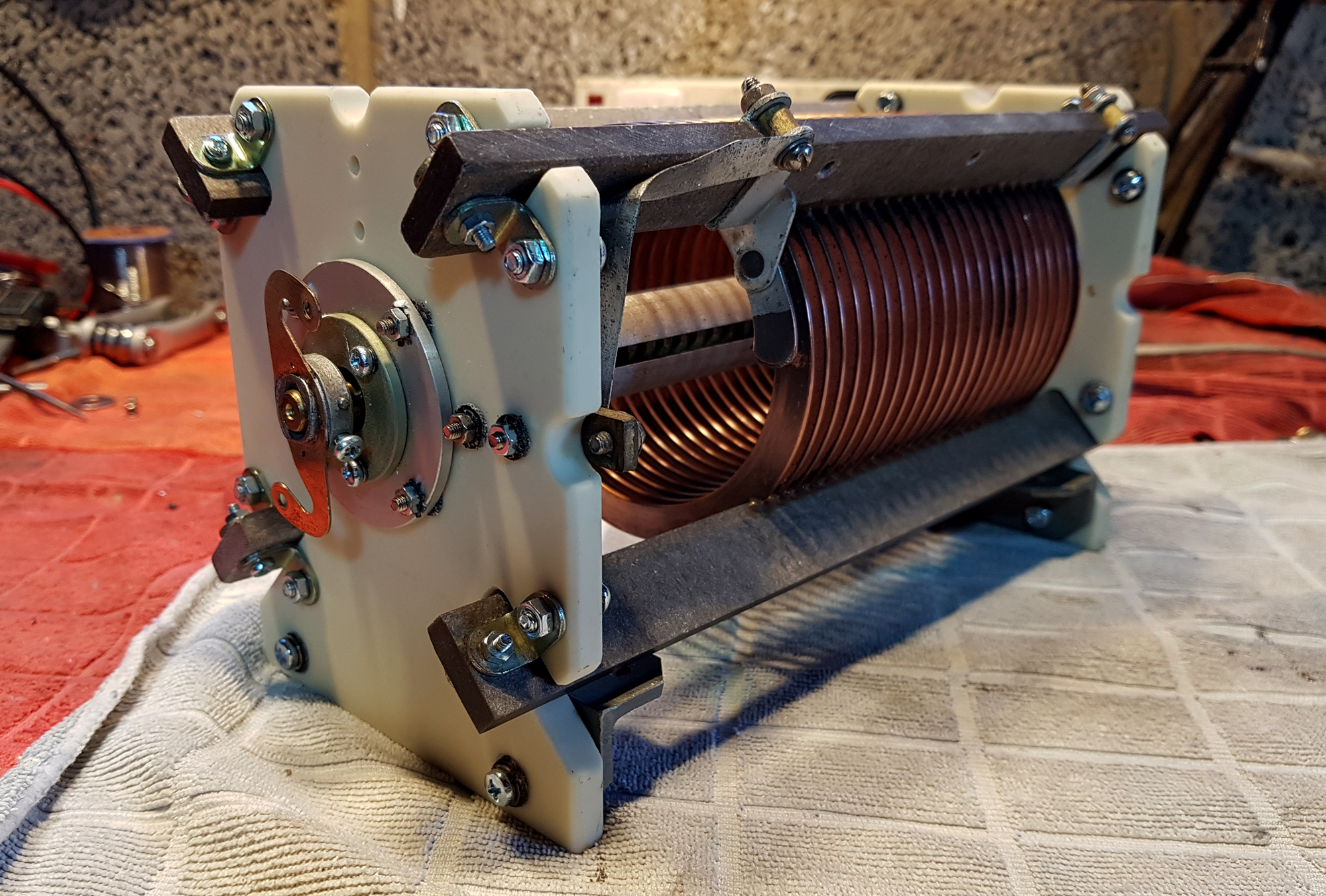
As with most cold-war soviet components, everything was engineered with so much ‘overhead’. I’m using ‘L1’ which is advertised as covering 0-17uh. I’m actually seeing 20.10uh on the meter here so you get an extra +3uh for ‘free’ 😊. More on this gem in the coming weeks.
The initial schematic is below but I can see it contains [un-necessary] switching as I have relays and rotary switches on the same switching lines. Since the original draft, I’ve sourced some quite hefty rotary switches from the USA so [most] of the relays may not be required.
I’ll publish a revised schematic once wiring has started and will be updating this article during 2025 as the build progresses – so stay tuned!
Thanks to Frank K7SFN for the additional help so far and giving me the ‘push’ to have a go.

